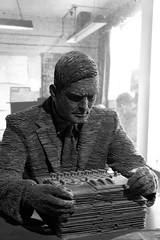
Misunderstanding a theorem
Over on New Oxonian, Hoffmann is at it again. In “Proving What?” Joe is amused by the recent Bayes’ Theorem (BT) “fad,” championed by Richard Carrier. I’ll leave it to Richard to answer Joe more fully (and I have no doubt he will), but until he does we should address the most egregious errors in Hoffmann’s essay. He writes:
So far, you are thinking, this is the kind of thing you would use for weather, rocket launches, roulette tables and divorces since we tend to think of conditional probability as an event that has not happened but can be predicted to happen, or not happen, based on existing, verifiable occurrences. How can it be useful in determining whether events ”actually” transpired in the past, that is, when the sample field itself consists of what has already occurred (or not occurred) and when B is the probability of it having happened? Or how it can be useful in dealing with events claimed to be sui generis since the real world conditions would lack both precedence and context?
I must assume that Joe has reached his conclusion concerning what he deems to be the proper application of Bayes’ Theorem based on the narrow set of real-world cases with which he is familiar. He scoffs at Carrier’s “compensation” that would allow us to use BT in a historical setting:
Carrier thinks he is justified in this by making historical uncertainty (i.e., whether an event of the past actually happened) the same species of uncertainty as a condition that applies to the future. To put it crudely: Not knowing whether something will happen can be treated in the same way as not knowing whether something has happened by jiggering the formula.
Different values yield different answers!
I’m not sure what’s more breathtaking: the lack of understanding Hoffmann demonstrates — a marvel of studied ignorance — or the sycophantic applause we find in the comments. Perhaps he’s getting dubious advice from his former student who’s studying “pure mathematics” (bright, shiny, and clean, no doubt) at Cambridge who told him:
Its application to any real world situation depends upon how precisely the parameters and values of our theoretical reconstruction of a real world approximate reality. At this stage, however, I find it difficult to see how the heavily feared ‘subjectivity’ can be avoided. Simply put, plug in different values into the theorem and you’ll get a different answer. How does one decide which value to plug in?
You don’t have to do very much research to discover that Bayes’ Theorem does not fear subjectivity; it welcomes it. Subjective probability is built into the process. And you say you’re not sure about what value to plug in for prior probability? Then guess! No, really, it’s OK. What’s that? You don’t even have a good guess? Then plug in 50% and proceed.
It’s Bayes’ casual embrace of uncertainty and subjectivity — its treatment of subjective prior probability (degree of belief) — that drives the frequentists crazy. However, the results speak for themselves.
And as far as getting different answers when you plug in different numbers, that’s a common feature in equations. Stick in a different mass value in F = ma, and — boom! — you get a different value for force. It’s like magic! Good grief. What do they teach at Cambridge these days?
The proper application of BT forces us to estimate the prior probabilities. It encourages us to quantify elements that we might not have even considered in the past. It takes into account our degree of belief about a subject. And it makes us apply mathematical rigor to topics we used to think could be understood only through intuition. Hence BT’s imposed discipline is extraordinarily useful, since we can now haggle over the inputs (that’s why they’re called variables) rather than argue over intuitive conclusions about plausibility — because truthfully, when a scholar writes something like “Nobody would ever make that up,” it’s nothing but an untested assertion.
Bayes’ Theorem ascendant
If you can possibly spare the time, please watch the video after the page break. In it, Sharon Bertsch McGrayne, author of The Theory That Would Not Die: How Bayes’ Rule Cracked the Enigma Code, Hunted Down Russian Submarines, and Emerged Triumphant from Two Centuries of Controversy recounts the story of how Bayes’ Theorem won the day. She tells us how BT is well suited for situations with extremely limited historical data or even no historical data — e.g., predicting the probability of the occurrence of an event that has never happened before. Continue reading “Proving This! — Hoffmann on Bayes’ Theorem”






